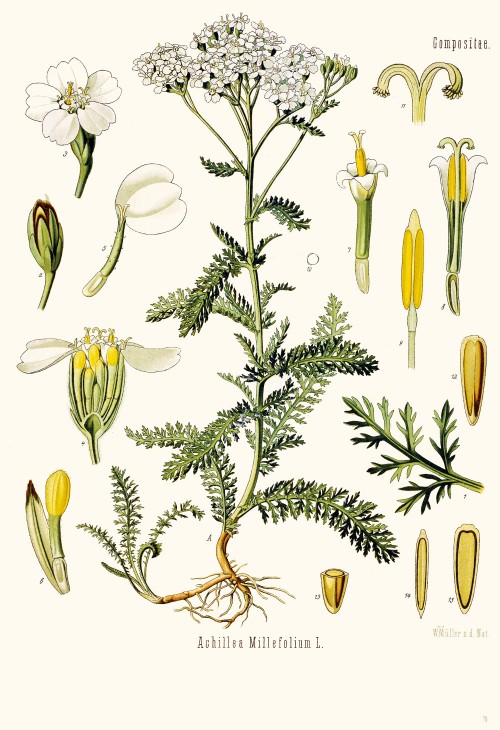Dies ist eine alte Version des Dokuments!
Achillea millefolium L. - Asteraceae - Common Yarrow, Milfoil, Woundwort, Bloodwort, Tansy, Gemeine Schafgarbe, Wiesenschafgarbe
Aromatic rhizomatous perennial, native to Europe, West Asia, North America; 0.20-0.80m high, stems simple or branched; leaves pinnately dissected, the blade 3-15 cm, to 2.5 cm wide, the basal petiolate, all but the lowermost cauline sessile; heads numerous in a flat or round-topped, short and broad, paniculate-corymbiform inflorescens, the disk 2-4 mm wide; ray flowers about 5, white or occasionally pink, 2-3 mm; disk-flowers 10-30; various habitats, but especially in disturbed sites; circumboreal; fl. time June-Nov.
The air-dried aerial parts of Achillea millefolium (yarrow, milfoil, Millefolium, Herba millefolii, Millefolii Herba, Schafgarbenkraut), gathered during the flowering period from June to September, have been used for a long time. The Greek hero Achilles (ca. 1200 B.C.) is said to have used the leaves to stop the bloodflow of his wounded soldiers. The drug got mention in numerous of the great herb books of the Middle Ages.
Yarrow contains flavanoids, tannin, chamazulenogenic compounds, volatile oil (0.1-1%) and a bitter principle.
[BHP83, Wichtl, BI, CRC]
The drug is said to act spasmolytic, antiseptic, astringend. Said to be diaphoretic, antipyretic and hypotensive. It is used internally to treat inappentence, dyspeptic disorders, slight gastrointestinal spasms. BHP83 states the indications „fevers, common cold, hypertension“ among others, according to the claimed diaphoretic, antipyretic and hypotensive action. Externally as sitting bath to treat Pelvipathia vegetativa (painful spasms of the female pelvis with psycho-vegetative origin), tincture or liquid extract to treat wounds and inflammation of the skin. [BHP83]
The German Commission E a therapeutic guide to herbal medicine, approve mifoil to treat inappentence, dyspeptic disorders, and slight gastrointestinal spasms orally, and as sitting bath to treat Pelvipathia vegetativa.
[Bundesanzeiger: 1.2.1990., Heftnummer: 22a., ATC-Code: A15. Monographie BGA/BfArM (Kommission E)] http://buecher.heilpflanzen-welt.de/BGA-Kommission-E-Monographien/achillea-millefolium-schafgarbe.htm
It has been stated that the guaianolid alpha-peroxyachifolid is responsible for the allergic contact dermatitis caused by yarrow.
[Ruecker G, Manns D, Breuer J, Arch. Pharm. (Weinheim, Ger.) 324(12) (1991), 979-81]
Analysis of the volatile oil of Achillea millefolium plants growing wild in Greece showed the main constituents to be 1,8-cineole, camphor, borneol and lavandulol. A comparison of the main volatile constituents revealed that great infraspecific variation occurs.
[Kokkalou E, Kokkini S, Hanlidoe E, Biochem. Syst. Ecol. 20(7) (1992), 665-70]
Only the tetraploid Achillea millefolium subsp. collina has a blue oil, indicating the presence of chamazulene (up to 61%). Other subspecies do not yield blue oils, their oils contain isoartemisia ketone.
germacrene D (7-33%) and caryophyllene are also present.
[Steinegger, Haensel], [Cygan FC, Pharm. Zeitg. 139 (1994), 438-440]
„… flowering aerial parts of wild Achillea millefolium growing on the Mediterranean coast (Sardinia Island, Italy) and on the Atlantic coast (Portugal- Serra de Montemuro) were used as a matrix for supercritical extraction of volatile oil with CO2 (SFE)…. The results showed the presence of two type oils. The Italian volatile extracts (SFE and essential oil) are predominantly composed by alpha-asarone (25.6-33.3%, in the SFE extract and in the HD oil, respectively), beta-bisabolene (27.3-16.6%) and alpha-pinene (10.0-17.0%); whereas the main components of the Portuguese extracts are trans-thujone (31.4-29.0%), trans-crhysanthenyl acetate (19.8-15.8%) and beta-pinene (1.2-11.1%).“
[Chemical composition and biological activity of the volatile extracts of Achillea millefolium., Falconieri, D., Piras, A., Porcedda, S., Marongiu, B., Gonçalves, M.J., Cabral, C., Salgueiro, L., Natural product communications, 6(10), 2011, 1527-1530]
The yields of oil in 14 commercial samples of yarrow were ranged from 0.1%-1.0% (12 samples were in accordance with the European Pharmacopoeia requirements, not less than 0.2 % of essential oil). The most important components of the oils were chamazulene (0.8-44.3%), β-pinene (tr-23.3%), sabinene (0-16.5%), bornyl acetate (tr-15.8 %), (E)-β-caryophyllene (2.5-14.3%), (E)-nerolidol (tr-9.6 %), 1,8-cineole (tr-9.6 %), and germacrene D (0.2-7.8 %).
[Essential oil content and composition in commercial Achillea millefolium L. herbs from different countries., Raal, A., Orav, A., Arak, E., Journal of Essential Oil Bearing Plants, 15(1), 2012, 22-31]

Köhler,F.E., Medizinal Pflanzen, vol.1 t.70 (1887) [W.Müller]
http://plantgenera.org/species.php?id_species=11698
